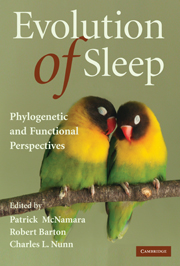Book contents
- Frontmatter
- Contents
- Contributors
- Acknowledgments
- Introduction
- 1 Ecological constraints on mammalian sleep architecture
- 2 Sleep in insects
- 3 Schooling by continuously active fishes: Clues to sleep's ultimate function
- 4 What exactly is it that sleeps? The evolution, regulation, and organization of an emergent network property
- 5 Evolutionary medicine of sleep disorders: Toward a science of sleep duration
- 6 Primate sleep in phylogenetic perspective
- 7 A bird's-eye view of the function of sleep
- 8 The evolution of wakefulness: From reptiles to mammals
- 9 The evolution of REM sleep
- 10 Toward an understanding of the function of sleep: New insights from mouse genetics
- 11 Fishing for sleep
- Index
- Plate section
- References
7 - A bird's-eye view of the function of sleep
Published online by Cambridge University Press: 10 March 2010
- Frontmatter
- Contents
- Contributors
- Acknowledgments
- Introduction
- 1 Ecological constraints on mammalian sleep architecture
- 2 Sleep in insects
- 3 Schooling by continuously active fishes: Clues to sleep's ultimate function
- 4 What exactly is it that sleeps? The evolution, regulation, and organization of an emergent network property
- 5 Evolutionary medicine of sleep disorders: Toward a science of sleep duration
- 6 Primate sleep in phylogenetic perspective
- 7 A bird's-eye view of the function of sleep
- 8 The evolution of wakefulness: From reptiles to mammals
- 9 The evolution of REM sleep
- 10 Toward an understanding of the function of sleep: New insights from mouse genetics
- 11 Fishing for sleep
- Index
- Plate section
- References
Summary
Introduction
Sleep has been detected in every animal that has been adequately studied (Cirelli & Tononi, 2008). The ubiquitous nature of sleep suggests that it evolved early in the course of evolution and therefore may serve a conserved function essential to all animals. This hypothesis forms the rationale behind the development of “simple” animal models of sleep (Allada & Siegel, 2008; Mignot, 2008). By studying sleep in animals such as the fruit fly (Drosophila melanogaster), where the power of genetic techniques can be readily employed, we may gain insight into the initial (perhaps cellular) function of sleep, a function that may still be relevant to understanding sleep in humans. Indeed, recent studies have already demonstrated remarkable similarities between sleep in Drosophila and sleep in mammals (Hendricks, Finn, Panckeri, et al., 2000; Shaw, Cirelli, Greenspan, et al., 2000; reviewed in Cirelli & Bushey, 2008). Although the utility of studying sleep in “simple” animal models is undeniable, it is unlikely that this approach alone will tell the whole story, especially given that Drosophila do not exhibit brain states comparable to mammalian slow-wave sleep (SWS) and rapid eye-movement (REM) sleep (Cirelli, 2006; Cirelli & Bushey, 2008; Hendricks & Sehgal, 2004; Nitz, van Swinderen, Tononi, et al., 2002). Indeed, the heterogeneous nature of mammalian sleep suggests that the specific changes in brain activity that accompany SWS and REM sleep might serve secondarily evolved functions not found in simple animals.
- Type
- Chapter
- Information
- Evolution of SleepPhylogenetic and Functional Perspectives, pp. 145 - 171Publisher: Cambridge University PressPrint publication year: 2009
References
- 3
- Cited by



